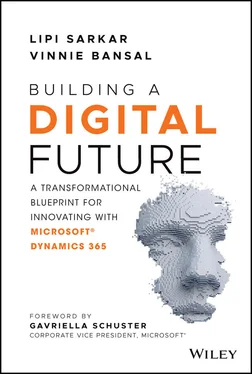Consumer engagement. While consumer or clients sit at the heart of digital transformation, it is the utmost priority to engage with consumers first to understand areas that can accelerate or improve the consumer experience
Cost efficiencies. We have all heard the phrase, “This software costs a fortune; we cannot afford it.” Indeed, the cost of implementation, maintenance, and licensing may become a big investment and the real ROI will most likely show up after user adoption. Hence there is a greater need to identify the business areas that can be made efficient that will eventually drive the growth of business, ensuring a cost-efficient investment.
Resistance to change. Humans by nature subconsciously resist change, especially when changes are initiated or forced by the external environment. Therefore, before initiating any transformation strategies or plans, business leaders should proactively draft initial risk assessments, regularly measure and track engagement and commitment from the very early stages of any project, communicate their expectations openly and honestly, but, most importantly, identify opportunities to motivate employees to become part of the planning process.
Old practices in a new environment. It is understandable that a digital transformation strategy is not solely the implementation of new systems but also the change in internal processes due to the ability to automate long and exhausting manual processes. Introducing the latest and most sophisticated technology without evaluating the old and setting new processes will certainly limit the potential of the whole endeavor.
The right product or the vendor. For this subject, there should be an option to make a choice. There are many examples where organizations chose the vendor over the product due to strategic relationships or hidden agendas, which unsurprisingly led to failed projects and broken relationships. Choosing the right product that suits the business and users should be a careful and transparent process, where possible guided by almost agnostic professionals who don't affiliate with vendors but lead the selection process through their experience and base their conclusions on results. In terms of the vendor, the main aim is to choose the right technology partner rather than the implementer who will engage and eavesdrop on the needs of the organization and encourage them to achieve more.
A Platform for Change and Transformation
As discussed throughout this book, it is already well known that we live in the digital age, and we are going through the digital transformation in our lives, politically, socially, and economically. This digital transformation is capable of changing our business models, ways of working and operating, all of which are supported by a technology ecosystem. The technological advancement in the last 20 years has been incredible, accelerating the growth of data and of connected people and devices, and, in the same way, it is expected to continue increasing many times in the short and medium term. Among the technologies that stand out the most in these advances are those related to the cloud, the Internet of Things, artificial intelligence, mobility, business applications, data analysis, and security, among others.
For an organization undergoing a digital transformation, selecting an implementation partner is a key decision. Usually, the selection of a partner is based on a tendering process fulfilling all key selection criteria. A good amount of time and due diligence needs to be factored in the selection process to identify the key strengths and weaknesses of the organization itself, which will contribute to selecting the right partner. However, after the partner is selected, many other factors need to be considered, both in terms of choosing the infrastructure and the technology. Having so many options in technologies and software available at the tip of your fingers, choosing the right solution for consumers who are not experienced and qualified can become the biggest nightmare of executives.
Most vendors will present you with their product's unique selling points and will certainly promise you that their software not only “can do the job” but eventually will offer you functionalities that will transform your business operations holistically. Without a doubt this could potentially add more value to a business that suffers from bureaucracy or poor business flows, but more functionalities should not be considered a primary selection criterion when these functionalities add nothing but cost to the project budget. Microsoft is one of the technological leaders in this field and is clearly one of the market makers, continuously developing new capabilities to enable digital transformation across an organization’s key business process. The public product roadmap provides information about what will be made available in the next wave of product updates.
At the end of 2016 the new Microsoft Dynamics 365 applications—a range of flexible applications adaptable to meet the needs of all types of industries, offering tools to transform their finance and operations, supply chain management, sales, customer service, commerce and marketing, and communication processes—was introduced. Microsoft also provides a low-code, non-code application development platform through the Microsoft Power Platform, including the market-leading tools for data analysis using Power BI, as well as a very extensive set of security, integration, artificial intelligence, data storage, processing services, and process orchestration, built on the Microsoft Azure platform. In particular, Microsoft releases two new functionality releases per year to Microsoft Dynamics 365 and the Microsoft Power Platform. Each release includes hundreds of new features, and this information is published in advance so that customers can properly prepare to adopt them.
We can highlight many great strengths within the Microsoft platform, like integrating with Cloud, integration with data, Power Apps, Power BI reporting, Finance & Operation, Supply Chain Management sized for large organizations, and Business Central for medium organizations, which make it an extremely attractive platform to support the digital transformation. The first is related to the completeness and integration of services and products. Virtually any requirement or problem that needs to be solved is already available within the stack of Microsoft products and services. A relevant aspect to adopting technology is that the products are natively integrated. A clear example of this is the integration between business applications and artificial intelligence. Microsoft has developed a series of services and functionalities using artificial intelligence technologies embedded within business applications, for example, within the sales application, so that users proactively know what the next best action is to consider, thus winning the business engagement since the sales engagement process is embedded within the functionalities. The second has to do with the evolution of the platform. Microsoft's investment in innovation and development allows customers to trust that the roadmap of Microsoft products and services will be able to meet business requirements and needs that are not yet known or clear today. Technology changes so fast that a system that was implemented two years ago, perhaps even today, is beginning to become obsolete. Microsoft services are constantly evolving and updating. For instance, all business applications undergo two annual updates, adding an average of 400 new functionalities each time, and each update can be silently adopted without disrupting the day-to-day usage.
These two characteristics of the Microsoft platform make it much simpler for a company to be able to adopt technology and transform its business model, optimize its processes, or create new products or services. From experience, a successful digital transformation strategy must include the adoption of products and services versus the adaptation of them. In addition to taking advantage of the good practices that are already included in the product, adopting further technologies allows a faster implementation, and cost-effective, efficient future maintenance of the solution. However, there are scenarios in which customizing the functionalities and services provided by Microsoft have competitive advantages by differentiating the product from other competitors. Any variation or customization of the product needs to be ring-fenced, closely measured with impact assessment, and monitored by solution design and architecture authority.
Читать дальше












